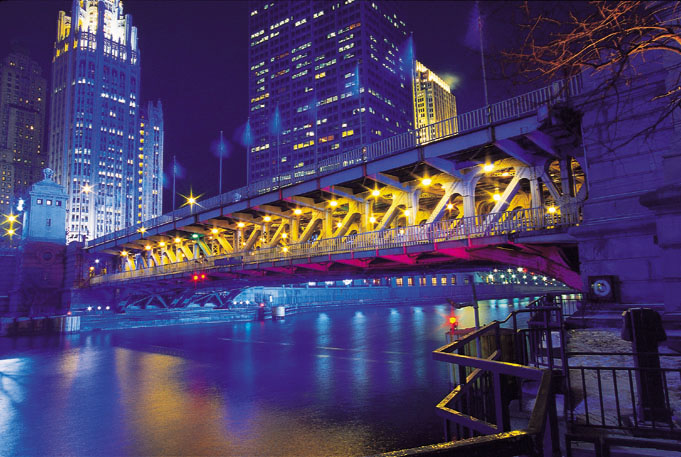
Chicago Dons
Purple to Salute Northwestern Sesquicentennial

Purple will reign both
over and under the Chicago area to help celebrate Northwestern's Sesquicentennial
(150th) anniversary, which officially occurs Jan. 28.
Local and state governments
have issued congratulatory resolutions for the University. And in
a display of purple pride, several major Chicago buildings and downtown
bridges will be bathed in purple light the week of Jan. 29.
Buildings that will
be lit in purple include the new Goodman Theatre, Sears Tower, the
Aon Center (formerly the Amoco building) and the 900 North Michigan
(Bloomingdale's) building. The floodlights that illuminate the undersides
of City of Chicago bridges over the Chicago River from Columbus Drive
west and south through the Loop also will be colored purple.
On Northwestern's Evanston
campus, the clock tower at Rebecca Crown Center and the floodlights
on Deering Library will also take on a purple hue.
"We're honored
to have all the government resolutions of congratulations, and the
lights are just a lot of fun," said Monica Metzler, Sesquicentennial
director. "It's a way of sharing the celebration."
Although the University's
founding trustees first met in 1850, Northwestern officially was created
as an institution when the State of Illinois granted the University
a charter on Jan. 28, 1851. Signed by Gov. A.C. French, the charter
set out the terms for trustees and gave the board broad powers, including
"erecting and completing suitable buildings, supporting necessary
officers, instructors, and servants, and procuring books, maps, charts,
globes, and philosophical, chemical and other apparatus necessary
to the success of the institutionâ"
The charter specified
that the institution would remain located in or near the City of Chicago
in Cook County and that the University could own up to 2,000 acres
of land. The first amendment to the charter, passed four years later,
specified that all the University═s property "shall be forever free
from taxation for any and all purposes." That amendment also included
a section —much more controversial at the time — that prohibited
the sale of liquor within four miles of the University. That prohibition
was not repealed until 1972 and kept Evanston a dry town for more
than 100 years.
It wasn't unusual for
universities or other private institutions to be given charters by
the state, said Patrick Quinn, university archivist. "State government
at that time was very minimal and there was no public university system
even being considered. So legislatures would give charters to private
institutions to provide those services."
Other institutions of
higher education received charters from the state earlier, including
McKendree College in 1835 and Knox College in 1837, but Northwestern
was the first in the Chicago area to be chartered.
Chicago Mayor Richard
Daley, Illinois Gov. George Ryan and Evanston Mayor Lorraine Morton
this week issued resolutions of congratulations to Northwestern on
behalf of Chicago, the state and Evanston.
When the Illinois legislature
and Congress reconvene, they are expected to introduce resolutions
honoring the University. In addition, the Cook County Board passed
such a resolution last spring when Northwestern celebrated the Sesquicentennial
of the first meeting of the trustees.
"All of our elected
officials have been very supportive of the resolutions and proclamations
honoring the University's Sesquicentennial," Metzler said. "It'll
be something to put in the University Archives for the bicentennial."
1/24/01
(Back)